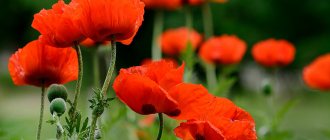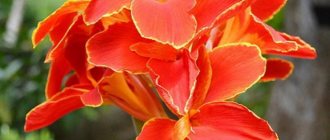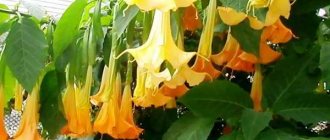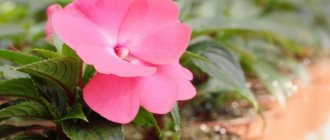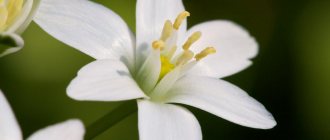Garden buttercup or ranunculus is a herbaceous perennial. Its delicate flowers simultaneously resemble a rose and a chrysanthemum.
In temperate climates, two types of plants are grown: Asian and African.
The tubers do not tolerate cold winters well, so buttercups are dug up in the fall.
Ranunculus cannot be called an unpretentious crop, but its bright colors and long flowering period make all the trouble worth it.
Botanical description
Ranunculus or Asian buttercup belongs to the Ranunculaceae family. The plant comes from Asia Minor. The bush can reach up to 80 cm. The shoot is powerful, the leaves are dissected in a rich green color. Inflorescences can be of different colors, reaching up to 10 cm in diameter. The root system is of the tuberous type.
Buttercup blooms from May to August. The buds remain attractive for a long time. That’s why flowers are often used for cutting and arranging bouquets.
The sap of the plant can lead to poisoning, so you need to wear gloves when working in the garden.
Types of buttercups
There are dozens of varieties of buttercups, but we have chosen the most popular, beautiful and unpretentious among them. Choose the option you like!
Asian buttercup
Not too tall, up to 45 cm, a species with fairly large flowers up to 5 cm in diameter. It is this variety that most densely double varieties belong to. And it is this that is most often called ranunculus.
Photo: ru.wallpaper.mob.org
Multifloral Ranunculus
This species has a different structure of a shortened root system. The stems are straight, but very branched, with slight yellowish pubescence and the same bright yellow flowers.
Photo: x-travels.ru
Buttercup Masha
A very beautiful and decorative hybrid that landscape designers adore. It is miniature and compact, so it is wonderful for border compositions.
Photo: ogorodnik24.ru
African buttercup
Another decorative group of varieties with densely double beautiful flowers. There are a lot of interesting and complex colors for the garden and flower beds.
Photo: 7dach.ru
Marsh Buttercup
The variety is not particularly notable for its beauty, but it is a good option for swampy and wet areas. The flowers are white, with a yellowish center, and the stems are thin, long and bare.
Photo: zelenj.ru
French buttercup
This group is united by the structure of the buds. Delicate petals are collected in two rows and form semi-double flowers.
Photo: liveinternet.ru
peony buttercup
Now such varieties can be classified as a separate category of hybrids. This includes buttercups with the largest flowers – about 10 cm.
Photo: 2sotki.ru
Verbena (85 photos): types, proper care
Varieties
The following types of ranunculus are distinguished.
French
Bush with buds in the shape of a ball. The terry petals are tightly packed, so during the blooming period the plant looks like a peony. The inflorescences can be of different shades, but there is a dark spot in the center of the flower. This is a kind of distinctive feature of the species.
Turkish
The bush has a tall stem and a large number of leaves. The buds can reach up to 12 cm in diameter. Externally, the flowers are similar to peonies, but after full opening they resemble double poppies.
Garden
Medium-sized bush with dissected leaves. The buds look like a rose. Often grown to decorate flower beds.
Bulbozus
The bush is compact in size, reaches a height of only 30 cm. The leaves are rich green in color, densely located on the shoots. Inflorescences are single golden in color.
Creeping
Buttercup shoots can reach 30 cm in length. The leaves are dissected and densely located on the shoots. During the flowering period it is covered with small yellow buds.
Tall Aconitofolia
Bush up to 1 meter high. The leaves are large, dissected, and during the flowering period it is covered with yellow buds.
Anemoleum buttercup
The bush is small in size and is most often grown as a houseplant.
Persian
A distinctive feature of the plant is its early flowering at the end of May. The inflorescences are located on high shoots and are similar to a rose.
In addition to the listed species, there are buttercups that grow in natural conditions. There are more than 400 such species, each of which has its own unique external characteristics.
Garden buttercup, its varieties
Ranunculus garden is a plant bred using selection from the Asian buttercup:
| Varieties | Description | Flowers |
| Masha | A small branched plant up to 40 cm tall, with feathery leaves. | Terry in different shades, including white and pink. |
| Terry (peony) | One of the most beautiful among buttercups is called the “bride flower”. | Large terry in various shades, including purple. |
| French | As the name suggests, it was obtained by European breeders. | Semi-double in various shades. |
| Persian | Up to 40 cm in height, the leaves are pinnate. | Semi-double medium. |
| turban-shaped | Leaves are slightly dissected. | Large spherical, petals curled inward. |
Popular varieties
Among the large assortment of ranunculus that can be grown in a flowerbed, the most popular varieties stand out.
Pink
Ranunculus are used for growing, in flower beds and along the border. Bushes of average height up to 20 cm. Up to 6-7 buds can form on one plant. The flowering period of buttercups begins in May and ends in September. The inflorescences are medium in size, bud diameter up to 8 cm.
Orange
An unusual plant that attracts with its appearance. The height of the bush can reach up to 50 cm. The leaves are large and dissected. During the flowering period, 2-3 peduncles of bright orange color appear on the bush. Externally, the peduncles look like rosebuds.
Elegant
A special feature of buttercups is the unusual color of the buds. During the flowering period, inflorescences can be of several shades at the same time. The most popular are lemon flowers with purple splashes. This variety is often used not only to decorate flower beds, but also to create unusual bouquets.
Festival
Ranunculus is distinguished by large buds. Most often, the flowers are painted white, cream or pale pink. However, a distinctive feature of the variety is the bright green spot in the center of each flower.
Picoti
A special feature of the variety is that the flowers are pink, but the border may be dark. Externally, the inflorescences are similar to a double peony, but after full opening the green core is noticeable.
Pon-pon
The name of the variety fully corresponds to the appearance of the flower. During the flowering period, the bush is covered with dense inflorescences that look like lush balls. Colors can vary, but the most common are red and white.
Bicolor
The plant is very popular in floriculture. It reaches a height of up to 60 cm. During the flowering period it is covered with bright flowers of different colors. A special feature of the variety is the presence of pink streaks along the edges.
Success
The tall variety is distinguished by unusual delicate buds of various colors, but the most popular are the white inflorescences. A special feature of the variety is that the plant is immune to fungal diseases.
Andrea
An unusual variety that is very popular among gardeners. Terry petals are gathered into a tight bud. As it opens, the flower resembles a peony. Buttercup can be of different colors from pink to crimson.
Victoria
A small compact bush can be used for growing both in open ground and in pots. The height of the plant is up to 30 cm, a feature of the variety is a large number of buds up to 10 on one plant. Despite the fact that the inflorescence is only 4-5 cm in diameter, its bright color makes ranunculus popular among gardeners.
Blooming Valley
The buttercup variety Blooming Valley is often grown for cutting. Bushes up to 50 cm high retain their attractiveness for a long period. Medium-sized buds can be painted in different colors. However, the red color of the ranunculus is considered the most popular.
Bloomingdale F1
A distinctive feature of ranunculus is the variety of colors. The height of the bush is only 20 cm; up to 5 double flowers can form on one shoot. The Bloomingdale F1 variety tolerates sudden changes in weather conditions well and is suitable not only for an open area, but also for growing in a pot.
Color Carnival
The height of ranunculus bushes can reach up to 70 cm, so this variety is often used for cutting. The inflorescences are large in diameter and can reach up to 10 cm. The colors vary from pink to bright red.
Superbissima
This variety belongs to the tall variety. The height of an adult bush is 60-70 cm. The crop blooms with pink, pastel and red inflorescences. The petals are terry with a delicate pleasant aroma; the crop can be used for cutting.
Amandine Pink
A variety that tolerates partial shade well, so it is often grown as an additional decoration for a flower bed. A special feature of ranunculus are its delicate buds, painted pink. The shoots are fleshy, erect; up to 10 small buds with a diameter of 5-6 cm can form on one bush.
Ranunculus season. Ranunculus season
Ranunculus is also known as ranunculus if you use the transliteration from Lat. Ranunculus is a flower of the Ranunculaceae family that has its own seasonality, which can be divided into three stages:
- October - early November - beginning of the season. At the beginning of the season, ranunculus have a small bud on a thin bendable stem. The stem of the early flower is very brittle and practically does not hold in the bouquet. Such flowers are suitable only for low compositions. The color range at the beginning of the ranunculus season is limited and is represented mainly by a white and pink palette.
- Mid-November – April is the main season. The color range is varied, the flower buds are large on a thick stem. The bud is dense and has the greatest resistance to wilting.
- The first half of May is the end of the season. Small flowers, limited color range, thin and brittle stem. At the end of the season, you can still find large buds of ranunclus, but the thin and bendable stem does not allow them to be fully used in bouquets. These flowers are ideal only for floral arrangements.
We prefer to work with ranunculus during the main season. Bouquets and flower arrangements collected at this time from large and dense buds on a thick stem have the most ideal appearance. Only in the main season, when ranunculus have a thick stem, are they able to retain their freshness for the longest possible time.
We also accept orders for ranuculuses at the beginning and end of the season, but we warn the buyer in advance about the imperfect quality of the flower, its size and limited color range. If we can still compensate for the size of the flower by increasing the number of flowers in the bouquet, the cost does not change, but resistance to wilting and a thin, brittle stem are the risks that the buyer takes on when ordering ranunculus in the off-season. At the beginning and end of the season, it is better to order not mono bouquets made up of ranunculus alone, but bouquets combined with other flowers. Roses, orchids, chrysanthemums in a bouquet with ranunculus will not only look spectacular, but will also support its thin and bendable stem. Mixed bouquets mean that there is a high probability that the ranunculus stem in them will not break and will ensure a guaranteed supply of water to the bud.
In the interior
Buttercups are often used in the interior of a room. The peculiarity of the buttercup is that with proper care the bushes will delight you with continuous flowering. Often grown on windowsills in small pots. With proper care, buttercups can bloom throughout the year.
How quickly does ranunculus sprout?
The earliest varieties may begin to bloom in May, while the later varieties may begin to bloom in early August. The average flowering time is about one month! Why does ranunculus not sprout
.
Interesting materials:
What is warmer, a camel blanket or a bamboo blanket? What is heavier: water or vegetable oil? Is there something eating the radishes in the ground? What is harder oak or beech? What is fertilized with bone meal? What can JBL Alice do? What's in a Mercury-free thermometer? What's in a room thermometer? What's in a glass unit? What does Tig welding cook?
In landscape design
Ranunculus is often grown in flower beds or along garden paths. Can be used as an independent plant or in combination with other crops. Looks good among evergreen shrubs.
Lavender (179 photos): planting and care in open ground and at home
Also, buttercup will be an ideal option for decorating a balcony or veranda. Potted buttercups can be placed in gazebos.
Buttercups – photo
Buttercups can turn any garden into a real fairy lawn. Just look how good they look in flower beds and group plantings!
Photo: oir.mobi
Photo: nmiddle.livejournal.com Photo: oir.mobi Photo: mykaleidoscope.ru Photo: mykaleidoscope.ru
Photo: mykaleidoscope.ru Photo: needpix.com
Photo: pixabay.com Photo: pixabay.com
Photo: pixabay.com
Photo: zen.yandex.ru
Photo: water-vao.ru
Photo: stom-mag.ru Photo: pixabay.com Photo: publicdomainpictures.net
Photo: br.pinterest.com
Photo: pxhere.com
Photo: keywordbasket.com
Photo: pixabay.com
Photo: astrussia.com
Photo: ru.wallpaper.mob.org
Photo: eva.ru
Photo: 7dach.ru
Photo: zen.yandex.ru
Photo: riderro.ru
Did you like the post? Subscribe to our channel in Yandex.Zen, it really helps us in our development!
Growing at home
In order for the plant to feel good at home, it is necessary to create favorable conditions for growth.
House conditions
In order for ranunculus to form buds, it is necessary to create conditions that will be close to natural.
| Conditions for keeping | Characteristic |
| Temperature | The suitable temperature for the growth of ranunculus is +20 – 22 ⁰С. In winter, it is permissible to reduce the temperature to +18⁰С |
| Humidity | Buttercup prefers moist conditions, so place a container of water near the pot. The liquid will evaporate and saturate the plant with moisture. |
| Lighting | Ranunculus needs bright, indirect light. Therefore, in the summer, the bushes are shaded a little so that burns do not form on the buds. |
| Where to keep | It is necessary to keep buttercups on southern windowsills. In summer, it is recommended to take flower pots out onto the balcony. |
Once a week, ranunculus can be sprayed with warm water from a spray bottle. However, when buds appear, such procedures are stopped. Drops of water harm the inflorescences.
When growing buttercups indoors in winter, it is necessary to use special phyto-lamps, since daylight hours are short and Ranunculus may feel a lack of light.
Care
The appearance of buttercups largely depends on proper care. Lack of attention can affect the growth of the flower and lead to problems.
Priming
For ranunculus, you need to use a nutritious soil mixture. You can purchase a ready-made substrate intended for Saintpaulias or make the mixture yourself. To prepare the soil yourself, you need to mix:
- humus 0.5 kg;
- chernozem 0.5 kg;
- coarse sand 0.5 kg;
- 1 kg of turf.
The resulting composition is thoroughly mixed and placed on a baking sheet. The soil is fried for 15 minutes in the oven at a temperature of 70 degrees.
Tara
For buttercups, use a pot with a capacity of 300 ml. There should be drainage holes at the bottom of the pot. If there are none, you need to make them yourself. Before planting the tubers, the container must be treated with boiling water.
You can germinate ranunculus tubers in a shallow container (no more than 10 cm high) filled with soil for seedlings. After the tubers sprout, the planting material is carefully moved into the pot.
Watering
Ranunculus prefers moderate watering, once every 4-5 days. However, it is important to monitor the condition of the soil. If the earthen ball has dried out, liquid is added; if the soil is wet, watering is postponed. You can check the soil moisture with your finger. If soil remains on the skin, there is no need to water the buttercup.
To water the ranunculus, warm water is used, which has been previously filtered. If there is no filter, you can use distilled tap water.
Fertilizer
In order for the buttercup to bloom profusely, you need to fertilize it in a timely manner, every 2 weeks. For buttercups, complex fertilizers are used, such as Master Agro, Avangard. During the period of active flowering, it is recommended to use fertilizers that contain potassium and phosphorus. The elements prolong flowering and stimulate the formation of new buds.
Trimming
Ranunculus is pruned only after flowering has finished. A faded bush is pruned at the root. This procedure is required in order for the tubers to accumulate the required amount of nutrients.
Transfer
Ranunculus does not tolerate transplantation well, so at home it is better to immediately plant the sprouted tuber in a suitable pot. However, if such a need arises, the plant should be replanted using the transshipment method. The flower is watered with water and removed from the pot with a lump of soil. It is transplanted into a new container, the gaps between the pot and the root ball are filled with soil.
Bloom
Ranunculus tubers are planted in March, so you can get a profusely flowering bush at the end of May. At home, the plant blooms not only in summer, but also in autumn. In order for the buds not to lose their decorative effect, faded buds must be regularly removed.
Rest period
From November to February the plant is dormant. This is required in order for the buttercup to please with abundant flowering in the spring. In order for the buttercup to retain its characteristics, you must perform the following steps:
- in the fall, when the flowers begin to form less and the leaves turn yellow, it is necessary to reduce watering to 1 time every 6 days;
- after the ranunculus begins to dry out, carefully cut the bush at the root;
- dig up the tubers and replant them in new soil;
- place in a cool, shaded place;
- in February the plant is placed on a sunny windowsill for the growth of new shoots.
It is better to replant before sending the buttercup to a cool place. This way you can inspect the tubers and remove damaged areas in a timely manner.
If rotten areas are found on the tubers, they must be carefully trimmed with a scalpel. Treat the cut area with a solution of potassium permanganate and dry it.
Caring for ranunculus at home
Once the ranunculus sprouts reach a few centimeters, the temperature is increased to +20 °C; when flowering, it is advisable to adhere to the regime of + 18 °C, otherwise the garden buttercup will quickly fade.
The key to growing at home is sufficient light. Therefore, a south-facing window is considered an ideal location, although the east and west sides are suitable. If the weather outside is warm, the ranunculus is taken out onto the balcony.
Water the Asian buttercup regularly as the substrate dries, preferably from above. During the growth period, fertilizers are added to the water. Ranunculus is sprayed periodically. After flowering is completed, watering is reduced.
Homemade ranunculus after flowering
To prolong the cultivation of home ranunculus, the flower is moved to a shaded and cool place, where it will continue to grow for some time. Then the leaves will turn yellow and begin to dry out along with the stem. During the dormant period, the buttercup is provided with new soil and a temperature of 15-18 °C. The domestic ranunculus rests for a month, and from mid-spring new shoots will begin to appear.
Growing in open ground
Growing ranunculus in open ground is not difficult even for novice gardeners. In order for the bushes to bloom profusely, you need to follow all agrotechnical care tips.
Selecting a location
The place for the growth of ranunculus should be in an open area and be well lit by the sun. It is not recommended to plant buttercups near bushes or fences. Lack of light can reduce the decorative effect of flowers. It is also necessary to choose an area that is protected from drafts and wind.
The soil
The soil for buttercups should be well drained. To prepare the site and soil, you should perform the following steps:
- carefully dig up the area with a shovel to a bayonet depth;
- remove old roots and stones;
- add humus at the rate of 10 kg per m2;
- For additional drainage, sand is added; 5 kg is used per 1 m2.
Everything is thoroughly mixed using a rake so that the soil becomes homogeneous.
Landing dates
Tubers should be planted in open ground at the end of April, early May. At this time of spring, the soil warms up to the desired temperature and the tubers germinate faster. If the buttercup will be pre-germinated indoors, it is necessary to plant the tubers in peat cups. Planting should be done in March. Thus, in May it will be possible to plant the grown seedlings in open ground.
If the tubers are purchased, before planting them in the ground it is necessary to treat them with potassium permanganate or Epin.
Watering
After planting, it is necessary to water the beds with buttercups every 3-4 days. After the first shoots appear, watering is reduced to 1 time every 5 days. If you water too often, the tubers may rot and the ranunculus will die.
Before watering, the soil around the bushes needs to be loosened. The procedure should be carried out carefully so as not to damage the tubers. Mulch is also used to retain moisture for a long period. For buttercup mulching, a mixture of humus and sawdust is used.
Fertilizer
Fertilizing for buttercups in open ground is carried out immediately after the leaves appear. The fertilization process should be carried out according to the following scheme:
- In the spring, after the appearance of the third leaf, nitrogen fertilizing is applied. Such substances are necessary for rapid growth;
- in early June it is necessary to use complex substances;
- During the period of active flowering, the buttercup is fed with potassium-phosphorus fertilizers.
It is important to keep an eye on your buttercups as they grow. If the ranunculus bush reduces the abundance of flowering, you need to add additional fertilizing using complex substances. Fertilizers such as biohumus, ammonophoska, superphosphate, and crystallon can be used for buttercups.
Trimming
Pruning buttercup bushes is carried out only after the crop has flowered. The bushes are pruned completely at the root. If this procedure is not carried out, new flowers will not appear.
Transfer
Transplanting buttercups is carried out only if the seedlings were previously grown indoors. To do this, you need to perform the following algorithm of actions:
- make a hole 20 cm deep in the prepared bed;
- if seedlings are grown in peat cups, there is no need to remove them. Plastic glasses are carefully removed so as not to damage the roots;
- The seedlings are planted in the ground and compacted.
After the ranunculus seedlings are planted, they must be watered with warm water. However, experts recommend immediately planting buttercup tubers in a permanent place of growth. Otherwise, the plant gets sick for a very long time and does not always recover after transplantation.
Bloom
Ranunculus begins to bloom in open ground at the beginning of summer. Flowering is abundant and continues until the end of August. With proper care, some varieties can produce buds even in September.
Rest period
In open ground, the dormant period for buttercups begins in October. After the tops dry out, they must be cut off so that the ranunculus tubers accumulate the required amount of nutrients.
Preparing for winter
Preparing ranunculus for winter can be done in two ways:
- digging up tubers. In order to preserve all varietal characteristics, the plant must be dug up at the end of October. The nodules are placed in sawdust and stored in a cool place until spring;
- insulation of roots in the soil. This method is most often used for the southern regions. After the tops of the buttercups are cut, it is necessary to cover the bed with humus and fallen leaves.
In the northern regions, ranunculus tubers do not tolerate wintering in open ground well, so they may die.
Spring treatment of plants after wintering in open ground
If the ranunculus overwintered in open ground, in the spring you need to perform the following steps:
- use a rake to remove leaves and other types of insulation;
- dig up the tubers and inspect for rot;
- separate daughter tubers from mother tubers;
- Soak the tubers for 15 minutes in a solution of potassium permanganate and plant them in the ground.
If the tubers have begun to form green sprouts, there is no need to dig up the plant; just feed it with nitrogen fertilizers.
Reproduction
Buttercup propagates both by tubers and by seed. Each method has its own characteristics that must be taken into account.
Seeds
Buttercup seeds have low germination capacity, but can also be used for propagation. Planting takes place at the end of February. In order to get ranunculus at home, you must follow the following recommendations:
- prepare a container 10 cm deep. Make drainage holes at the bottom of the container;
- fill the seedling container with humus mixed in equal proportions with peat;
- carefully spread the seeds over the surface of the soil and press them slightly into the soil;
- pour warm water using a spray bottle;
- cover with film and place in a sunny area.
Once a day, open the greenhouse and moisten the soil. After the sprouts appear, the film is removed. The suitable temperature for the growth of buttercups is +15 to +17⁰С. After the formation of the third true leaf, it is necessary to pick into separate cups.
Tubers
Propagation by tubers is the easiest method to obtain an adult ranunculus bush. During the summer, the tubers form a large number of children, which are separated from the mother material in the fall and planted in open ground in the spring.
Before planting, it is necessary to carry out spring treatment of the planting material. To do this, the following algorithm of actions is performed:
- planting material is carefully inspected for damage and rot;
- line the bottom of a shallow container with a napkin;
- place planting material;
- pour warm water so that the top of the tubers is open;
- cover with a napkin on top.
Leave it like this for 3-4 hours. After such soaking, it is necessary to immediately plant the tubers in the ground.
Content
- Where to begin
- We revive and germinate the “roots”
- Ranunculus in a flower garden
- Planting care
I would never have thought that the garden buttercup (ranunculus) is a relative of wild field and meadow buttercups , represented by modest and absolutely discreet forms and yellow colors. After all, breeders are magicians and sorcerers, their work is akin to magic.
Capri23auto / Personal archive
Unlike their “brothers,” varietal ranunculus (hybrids based on Asian buttercup ) are luxurious, delicate and sweet creatures. Their decorative properties and varied colors are appreciated by flower growers. Garden buttercups flowers , of various colors, with a diameter of almost 10 cm . The shape of different varieties differs, they resemble carnations, roses, poppies, but for me the peony-shaped ones are especially attractive. When looking at such exquisite beauty, I am sure that no one is indifferent.
CGWF/Flickr.com
manuel mv / Flickr.com
Pests
Buttercup is resistant to pests. However, in some cases insects appear, which in a short time lead to the death of the flower bed
| Pest | How to identify | Struggle |
| Aphid | A small insect feeds on the sap of the plant. In order to identify the problem in a timely manner, it is necessary to carefully examine the leaves and young shoots. | To combat aphids, you can use a solution of household mala. To do this, dissolve 100 grams of soap in 5 liters. |
| Nematodes | Small compactions that most often form in the root area. It is difficult to identify pests in a timely manner. | Root nematodes are difficult to treat, so the buttercup is removed along with the roots. The soil where the flower grew must be treated with boiling water. |
| Cabbage butterflies | Small insects that lay larvae. The larvae damage the shoots and cause the plant to die. | To combat the pest, it is necessary to use the drug Aktara. |
| Spider mite | The pest manifests itself as small compactions on shoots and leaves. When attacked by insects, the buds may fall off. Another symptom of the pest is small threads of cobwebs between the leaves. | To combat the pest, it is recommended to use the drug Actellik |
| Thrips | Insects that feed on plant sap. They appear as compactions, which most often form on the leaves. When the buttercup is infected with thrips, the buds dry out before they have time to open. | To eliminate the problem, it is necessary to treat the bushes with drugs such as Iskra, Akarin. |
You can identify pests in a timely manner if you regularly inspect the ranunculus bush. At the first symptoms of harmful insects, appropriate control measures must be taken. If neglected, chemicals may not be effective, and the crop will need to be uprooted.
Diseases and pests of Asian ranunculus
The buttercup family is quite resistant to disease. Most often, garden varieties suffer from diseases due to improper agricultural practices.
Excessive watering, rainy summers and fogs provoke powdery mildew.
The fungus covers young leaves. In advanced cases, the buttercup dies.
Fertilizing with potassium fertilizers increases the plant's resistance.
Effective drugs are “Fitosporin”, “Zato” and “Quadris”.
During dry summers, spider mites settle in flower beds and feed on plant sap.
The leaves at the puncture sites become covered with yellow spots. The bushes are sprayed with acaricides “Vermitek”, “Akarin”, “Aktellik”.
During a tick-borne epidemic, medications can be alternated.
Diseases
Ranunculus, when properly cared for, is rarely susceptible to disease. However, problems may arise.
| Disease | Symptoms | Treatment |
| Root rot | Occurs if the plant is watered too often. The first symptoms of the disease are yellowing of leaves and lethargy of shoots. | For treatment, it is necessary to reduce watering and dry the soil. If the flower is grown in a pot, it must be transplanted into new soil. |
| Powdery mildew | White coating on the leaves. The affected areas begin to dry out. | For treatment, a light solution of Bordeaux mixture or the drug Fitosporin is used. |
| White mold | Formation of gray plaque on the leaves. Appears when there is a lot of moisture. | For treatment it is necessary to treat with Fitosporin. |
To ensure that the buttercup is not exposed to disease, all care tips should be followed. A common cause of ranunculus problems is improper watering.
Feeding and care
Damaged and limp leaves should definitely be removed, because they slow down the entire flower growing system. Moreover, new leaves will soon appear in the same place.
Faded flowers also need to be removed regularly, as this will stimulate the formation of new inflorescences. After heavy rains, you need to loosen the soil so that the roots do not rot from excess moisture.
In order for the plant to be healthy, have lush flowering, and not succumb to disease, it is necessary to feed it in time with the missing microelements. It is recommended to do this once every two to three weeks. Organic matter plays a significant role in feeding, but only in reasonable quantities so that there is no excess of acids.
Problems during cultivation
In addition to pests and diseases, problems may arise that negatively affect the appearance of buttercups. Among the common problems that can arise when growing ranunculus are:
Appearance of yellow leaves
Yellow leaves on buttercups may appear as a result of insufficient watering. It is necessary to examine the lump and, if it is dry, moisten it. It is necessary to reduce watering and inspect ranunculus leaves for the presence of pests such as nematodes.
Leaves may also turn yellow if there are insufficient nutrients. If the plant has not been fed for a long period, it is necessary to apply complex fertilizers.
Doesn't bloom
Ranunculus may lack buds if the tubers are planted in the ground too late. In such cases, the crop does not have time to form buds. There may also be no inflorescences if the plant is grown in the shade. It is necessary to plant planting material in early spring; for this, choose a sunny area.
Drops buds
Buttercups may drop their buds as a result of too much watering. To eliminate the problem, watering must be reduced. A draft can also cause the buds to drop. If the ranunculus is frozen, the leaves will be limp and the buds will fall off before they open.
Leaves become covered with yellow spots and become sticky
If a sticky coating and small yellow spots appear on the leaves of the ranunculus, this indicates that the plant is affected by a pest such as spider mites. To eliminate the problem, it is necessary to treat the ranunculus with preparations such as Fitoverm or Neoron.
The foliage is curling
A problem arises when ranunculus tubers are affected by nematodes. You can try to save the culture. The tubers need to be dug up and kept in water at a temperature of 50 degrees. Then plant it in a new substrate.
Ranunculus or buttercup is often grown in a summer cottage. Due to the variety of varieties, the crop is used to decorate flower beds and garden paths. Bright buds can be used for cutting and forming bouquets. Also, an attractive plant can be chosen as an indoor flower and complement the interior. In order for the buttercup to please with its attractive appearance, it is necessary to follow all care recommendations.

